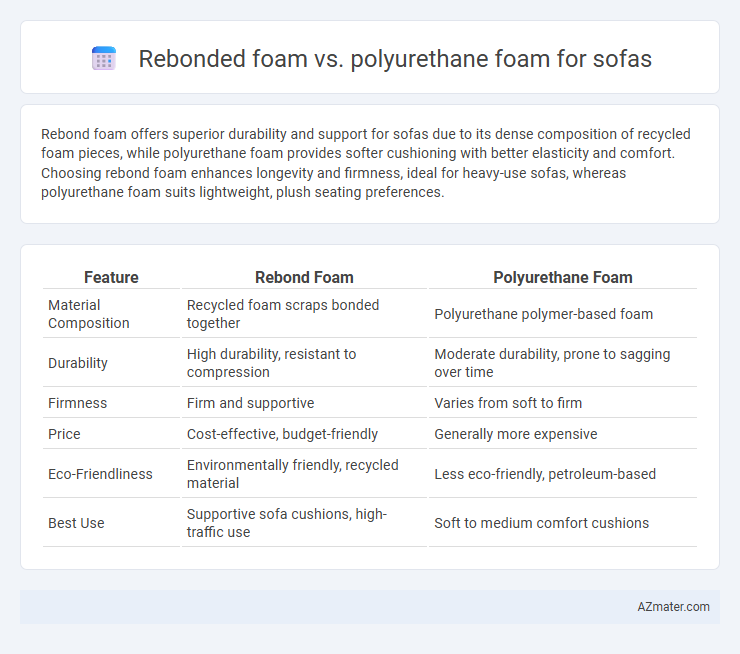Rebond foam offers superior durability and support for sofas due to its dense composition of recycled foam pieces, while polyurethane foam provides softer cushioning with better elasticity and comfort. Choosing rebond foam enhances longevity and firmness, ideal for heavy-use sofas, whereas polyurethane foam suits lightweight, plush seating preferences.
Table of Comparison
| Feature | Rebond Foam | Polyurethane Foam |
|---|---|---|
| Material Composition | Recycled foam scraps bonded together | Polyurethane polymer-based foam |
| Durability | High durability, resistant to compression | Moderate durability, prone to sagging over time |
| Firmness | Firm and supportive | Varies from soft to firm |
| Price | Cost-effective, budget-friendly | Generally more expensive |
| Eco-Friendliness | Environmentally friendly, recycled material | Less eco-friendly, petroleum-based |
| Best Use | Supportive sofa cushions, high-traffic use | Soft to medium comfort cushions |
Introduction: Understanding Sofa Foam Materials
Rebond foam and polyurethane foam are popular materials used in sofa cushions, each offering distinct comfort and durability characteristics. Rebond foam is made from shredded polyurethane foam pieces bonded together, providing high density and excellent support, ideal for heavy use and long-lasting resilience. Polyurethane foam, typically lighter and more flexible, offers a softer feel but may compress faster, making it suited for less frequently used furniture or those prioritizing initial comfort.
What is Rebond Foam?
Rebond foam is a type of high-density foam created by bonding shredded scrap polyurethane foam pieces together using a polyurethane adhesive, making it highly durable and resilient. It is commonly used in sofa cushions for its firm support and excellent shape retention compared to traditional polyurethane foam, which tends to compress and lose form faster. The rebond foam's enhanced durability and firmness provide a comfortable seating experience and extended lifespan in upholstered furniture.
What is Polyurethane Foam?
Polyurethane foam is a versatile cushioning material widely used in sofas due to its excellent durability, lightweight nature, and ability to provide firm yet comfortable support. This foam is produced through the chemical reaction of polyols and diisocyanates, resulting in a flexible material that can be customized for varying levels of density and firmness. Its cost-effectiveness and adaptability make polyurethane foam a popular choice for both budget-friendly and premium sofa cushions.
Comfort and Support Comparison
Rebond foam offers higher density and resilience, providing firm support and excellent durability for sofas, ensuring long-lasting comfort and shape retention. Polyurethane foam varies in density and firmness, often delivering softer cushioning but less structural support, which may compress faster under regular use. For optimal sofa comfort and support, rebond foam is preferred for heavy-duty seating applications, while polyurethane foam suits lighter, plush cushioning needs.
Durability and Longevity
Rebond foam offers superior durability compared to polyurethane foam due to its dense composition of recycled foam scraps bonded together, providing enhanced resistance to sagging and deformation over time. Polyurethane foam, while softer and more affordable, tends to compress and lose shape faster, especially under frequent use, reducing the sofa's overall lifespan. Choosing rebond foam significantly extends the longevity of sofa cushions, making it ideal for heavy-use furniture requiring sustained support and comfort.
Cost Differences: Rebond vs Polyurethane
Rebond foam typically costs 15-30% less than polyurethane foam, making it a budget-friendly option for sofa cushions without sacrificing durability. Polyurethane foam offers higher resilience and comfort but at a premium price, often costing between $20 to $40 per cubic foot compared to rebond foam's $10 to $25 range. Choosing between the two depends on balancing upfront cost savings with long-term comfort and performance needs.
Environmental Impact and Sustainability
Rebond foam, made from recycled scrap foam, significantly reduces landfill waste and lowers the environmental footprint compared to traditional polyurethane foam derived from petroleum-based chemicals. Polyurethane foam production involves substantial energy consumption and emits volatile organic compounds (VOCs), contributing to pollution and limited biodegradability. Choosing rebond foam supports sustainability by promoting material reuse and reducing reliance on non-renewable resources in sofa manufacturing.
Best Applications for Each Foam Type
Rebond foam excels in high-impact applications such as gym flooring and heavy-use sofa cushions due to its durability and density, offering superior support and resilience. Polyurethane foam is ideal for comfort-focused sofa cushions and upholstery, providing a softer, more flexible seating experience with excellent cushioning and breathability. Selecting rebond foam enhances longevity in commercial or frequently used furniture, while polyurethane foam suits residential furniture prioritizing comfort and light to moderate use.
Maintenance and Care Tips
Rebond foam requires regular vacuuming and spot cleaning with mild detergent to maintain its durability, while polyurethane foam benefits from routine fluffing and rotating to prevent sagging and deformation. Both foams should avoid excessive moisture exposure to prevent mold and odors, and using breathable sofa covers can extend their lifespan. Proper maintenance ensures prolonged comfort and structural integrity for sofas upholstered with rebond or polyurethane foam.
Which Foam is Better for Your Sofa?
Rebond foam offers superior durability and firmer support, making it ideal for high-traffic sofas that require long-lasting comfort and shape retention. Polyurethane foam provides a softer, more cushioned feel, suitable for those who prefer plush seating but may compress faster over time. Choosing the best foam depends on your sofa usage, with rebond foam excelling in firmness and longevity, while polyurethane foam caters to softer comfort needs.

Infographic: Rebond foam vs Polyurethane foam for Sofa
 azmater.com
azmater.com